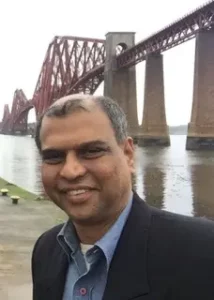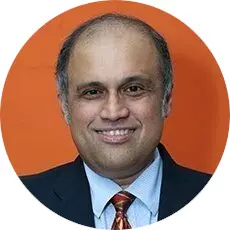A message from our Founder & CEO
Dear Readers,
If I may ask, how many of you have a bank account or access to financial services?
We are privileged to have access to these financial services: according to the World Bank and FDIC, globally, 1.4 billion adults do not have a bank account, and in the US alone, 7.1 million households do not. Many of the unbanked have lower income statuses, compelling them to use predatory financial services, such as check cashing or payday loans, which often have extremely inflated costs and fees, leading to a vicious debt cycle. The annual inflation rate of US has accelerated to record highs since the past few decades. This increase in the cost of living has exacerbated the need to manage and strategize our finances. It is imperative that everyone has safe and affordable access to savings and credit within the financial system, to work their way out of poverty, and expand economic opportunities. Financial Inclusion is defined as providing equal, easier, affordable, and larger access to financial services. Financial Inclusion empowers a person’s economic well-being, by allowing access to education, healthcare, home ownership, and basic necessities of life. A well-functioning financial system is key to increased national economic growth and welfare.
Financial Inclusion has become a global priority. The World Bank, United Nations, and IMF have started initiatives and programs in partnership with several nations to increase financial inclusion. The World Bank’s Universal Financial Access 2020 initiative focuses on 25 priority countries where almost 70% of all financially excluded people live, and is also working with more than 100 countries to advance financial access and inclusion. There has been progress: for example, in India, the government sponsored Jan Dhan initiative incentivized the population to open a bank account, and was a huge success, leading to more than 400 million people becoming banked, which is a Guinness World Record. In Sub-Saharan Africa, initiatives led mobile money account ownership to rise from 12% to 21%.
The four solution tenets that enable, accelerate and sustain financial inclusion are: Fintech, Improving Accessibility and Affordability, Financial Literacy, and Public Policy and Regulation.
In the US and globally, FinTech, which integrates Technology and Finance, has been a catalyst for financial inclusion initiatives. Digital Financial Services, such as mobile banking enabled by Fintech, increase access, have the potential to reduce cost, and increase efficiency and transparency, allowing for more customized financial services to serve the unbanked. COVID-19 has accelerated the use of mobile banking, and has pushed us towards realizing the benefits of innovative technology in financial services. As per the World Bank, in the last decade, 1.1 billion previously unbanked adults gained access to financial services, primarily due to the increase in FinTech and mobile money accounts.
Second is accessibility and affordability. We all know that an important key to an American Dream is a good credit score: credit scores dictate and determine the creditworthiness and ability to use financial services. Credit scoring focuses primarily on financial data, and mainly consists of traditional data points, such as credit cards, loans, banking usage data, financial transaction history, etc. This creates a sort of a catch-22 situation: the unbanked don’t have a bank account and are excluded from the credit reporting system, so they don’t have a credit history and find it hard to get access to financial services. Research and initiatives are underway on alternative credit scoring systems, which can incorporate non-traditional variables such as education background, e-commerce transaction data, etc, leveraging AI and Data Science, to extract data from alternative sources to determine creditworthiness. Recently, Equifax, which is one of the largest “credit score” providers, has partnered with a lab at the Georgia Institute of Technology to help research and utilize additional factors in their “score”, to make better and more inclusive decisions to impact the unbanked.
Additionally, according to the World Bank, the number one cited reason for not having a bank account is not having enough money to create one. The easiest solution to this is to decrease account minimums, and by increasing transparency about or eliminating hidden costs and fees. Although this may not alone be enough to solve financial inclusion, it will certainly increase accessibility and the affordability of financial services.
Third is financial literacy. The 2014 Alliance for Financial Inclusion Global Policy Forum (GPF), established 3 goals to tackle financial inclusion through literacy: make people more aware about the financial system, educate people about how they can use it, and protect consumers in the financial system. For example, India has hosted many immersive practical “financial literacy camps,” to help teach adults how to save, borrow, use a bank account, etc, which led to 95% of the attendees becoming banked. These types of initiatives could be replicated in other parts of the world too. According to a study by the Champlain College Center for Financial Literacy, only 11 states, including Georgia, have public policies that require at least 15 hours of formal Financial Literacy instruction within high school. These 11 states account for only less than 38% of all public high school students, with the rest receiving less than 15 hours of financial literacy instruction. Financial literacy in middle and high schools could be a national priority, since as the cliché but true saying goes, knowledge is power.
Fourth is public policy. Public policy is key for building a regulatory framework for financial institutions by eliminating barriers to financial inclusion, such as by bridging digital and knowledge divides and establishing transparent, safe, and fair lending practices. For example, in the US, the Financial Inclusion in Banking Act of 2021 focused on conducting research to report strategies to increase financial inclusion, and it passed in the House of Representatives. Another example is the Credit Access and Inclusion Act of 2021, which focuses on allowing the sharing of alternative data to credit reporting agencies. Numerous countries are adopting similar public policy initiatives to increase financial inclusion.
As a community, we are making progress, as in the last decade, 1.1 billion people who previously did not have bank accounts became banked. What we all can do, is be proactive to utilize resources in our community, educate and create awareness, advocate for financial inclusion public policies, and support and adapt new innovation and technologies. Together we can ensure no one is left behind. Thank you.


Author, “SKope: The Social Kaleidoscope – Economics of Global Social Equity” (https://www.amazon.com/dp/B0CL3C65GH/)
 Raj Mehta – Financial Education Instructor
Raj Mehta – Financial Education Instructor

